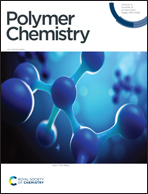Immortal polymerization of LA: the influence of steric effects, electronic effects and pKa on chain transfer agents†
Abstract
The “immortal” ring-opening polymerization (iROP) of L-LA, catalyzed by ligand-free Ca[N(SiMe3)2]2(THF)2 in combination with different chain transfer agents (alcohols, phenols and PhCH2NH2) was systematically investigated for the first time. When alcohols were used as CTAs (pKa: 14.36–12.73), the polymerization proceeded smoothly and efficiently in excess of PhCH2OH and Ph2CHOH feeding, through which the molecular weights of the obtained PLAs could be precisely controlled by the monomer/alcohols and the molecular weight distributions were maintained at a very narrow level, showing a typically immortal characterization. Upon increasing the steric effect of the alcohol (Ph3COH), the activity became lower and the molecular weight distribution became broader than those of PhCH2OH and Ph2CHOH, indicating that the steric effect of alcohols has a significant influence on the iROP of LA. Whereas for the phenol-based CTAs (pKa: 10.17–7.15), the electronic effect was obvious for the ROP of L-LA. When PhOH was used as a module, the activities and initiation efficiencies became slightly lower than those of alcohols, but the molecular weight distributions were kept relatively narrow, which could realize the iROP of L-LA under certain conditions. When PhOH containing a strong electron-withdrawing group (–NO2) was used, the polymerization became inert, while when p-CH3–PhOH with a weak electron-donating group was used as the CTA, the activities were high and the molecular weights and distributions were controlled by the monomer/CTA ratio. Therefore, the electronic effect of PhOH-based CTAs has a great influence on the ROP of LA. Upon further decreasing the pKa to 9.33 (PhCH2NH2), the polymerizations could smoothly proceed but the molecular weight distributions of the polymers were bimodal, showing that the polymerizations were uncontrollable. The study of the active species indicated that the Ca–O group was the initiation group for alcohol- and phenol-based systems. There exists two active species (Ca–NHCH2Ph/Ca–N(SiMe3)2) in the Ca[N(SiMe3)2]2(THF)2/PhCH2NH2 system. The polymerization kinetic behaviors showed that the catalytic activity follows the order of PhCH2OH > Ph2CHOH > PhOH > PhCH2NH2. The kapp of Ph2CHOH increased firstly and then decreased with the increase of the CTA, indicating that the CTA promoted the propagation of polymerization firstly and then decreased the propagation of polymerization.



 Please wait while we load your content...
Please wait while we load your content...